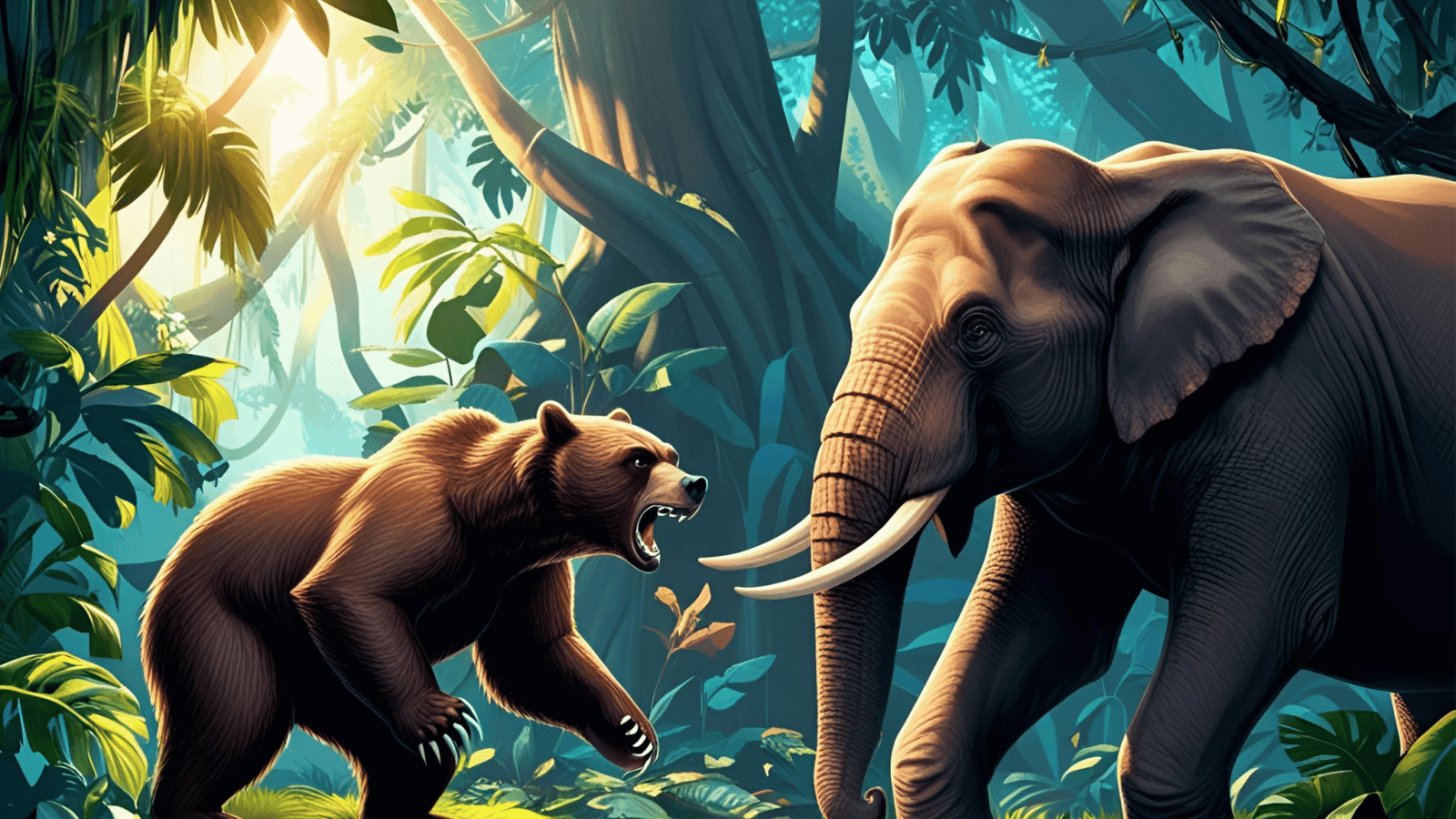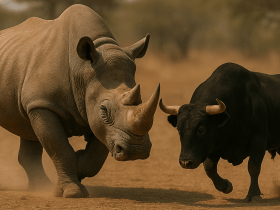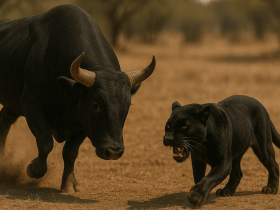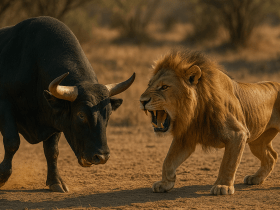Is this even fair? wait! Wait! Stay till the end ,With this article you will get to know all the specifications about these two powerful creations. Largest mammal on the earth vs a predator who has powerful bite and sharp claws, Are these claws really enough to hurt an elephant? Lets see… Below is a full detailed article about Bear vs Elephant who wins?
Bear (Ursus arctos / Ursus arctos horribilis)
Elephant (scientific name: Loxodonta africana for the African elephant).
Can this even happen in the real world? Why not! There is a possibility meet these two. with this Below tables I covered 10 main topics by including all the numerical and scientifical data by comparing Bear vs Elephant who wins . Also I have included a winner column for further understanding, Happy reading!
Hope you will enjoy!
1. Body Specifications
| Feature | Bear | Elephant | Winner |
|---|---|---|---|
| Height (at shoulder) | 90–150 cm | 250–400 cm | Elephant |
| Body Length | 1.7–2.8 m | 5.5–7.5 m | Elephant |
| Weight | 150–600 kg (Grizzly); up to 1,000 kg (Kodiak) | 3,000–6,500 kg | Elephant |
| Muscle Mass % | ~60% | ~40% (bulkier, not lean muscle) | Bear |
| Bone Density | High | Exceptionally high | Elephant |
| Skull Thickness | ~3–5 cm | Up to 10 cm | Elephant |
| Limb Strength | Extremely powerful | Crushingly strong | Elephant |
| Trunk Functionality | Absent | Over 40,000 muscles, multi-functional | Elephant |
| Tusk Presence | None | Present in males (1.5–2.5 m) | Elephant |
| Mass to Strength Ratio | High | Moderate | Bear |
Winner: Elephant
2. Coat and Coloration
| Feature | Bear | Elephant | Winner |
|---|---|---|---|
| Color Variation | Brown, black, white (polar) | Grey to dark brown | Bear |
| Hair Coverage | Thick fur | Sparse hair | Bear |
| Skin Thickness | 2.5 cm | 2.5–4 cm | Elephant |
| Camouflage | Moderate | Low | Bear |
| Melanin Level | Normal to high | Low | Bear |
| UV Protection | Via fur | Via thick skin and mud bathing | Elephant |
| Coat Function | Insulation | Heat regulation | Tie |
| Parasite Resistance | Moderate | High (mud, dust) | Elephant |
| Seasonal Shedding | Yes | No | Bear |
| Heat Regulation Mechanism | Panting, shedding | Ears, skin, mud | Elephant |
Winner: Tie
3. Habitat and Range
| Feature | Bear | Elephant | Winner |
|---|---|---|---|
| Global Range | Americas, Europe, Asia | Africa, Asia | Tie |
| Habitat Type | Forests, tundras, mountains | Grasslands, savannas, forests | Tie |
| Altitude Range | Sea level to 5,000 m | Sea level to 3,000 m | Bear |
| Temperature Tolerance | Extreme cold to temperate | Warm to tropical | Bear |
| Water Dependency | Moderate | High | Bear |
| Territorial Range | 20–500 km² | 50–1,000 km² | Elephant |
| Habitat Destruction Sensitivity | Moderate | High | Bear |
| Habitat Adaptability | High | Moderate | Bear |
| Urban Conflict Frequency | Occasional | Common in India/Africa | Bear |
| Migratory Behavior | Seasonal (some species) | Seasonal in Africa | Tie |
Winner: Bear — More adaptive to various climates
4. ️ Diet and Feeding Behavior
| Feature | Bear | Elephant | Winner |
|---|---|---|---|
| Diet Type | Omnivore | Herbivore | Tie |
| Daily Caloric Intake | 10,000–20,000 kcal | 70,000–150,000 kcal | Elephant |
| Feeding Duration per Day | 6–8 hours | 16–20 hours | Elephant |
| Food Sources | Fish, mammals, berries, roots | Grasses, bark, fruits | Tie |
| Feeding Mechanism | Paws, jaws | Trunk and tusks | Elephant |
| Prey Capture | Yes | None | Bear |
| Tool Use (Feeding) | Yes (occasionally) | Yes (branches, water tools) | Elephant |
| Digestive Efficiency | Moderate | Low (inefficient fermentation) | Bear |
| Food Storage | No | Sometimes (bark stripping areas) | Elephant |
| Nutritional Flexibility | Very high | Low | Bear |
Winner: Bear — More versatile
5. Strength and Defense – Bear vs Elephant
| Feature | Bear | Elephant | Winner |
|---|---|---|---|
| Bite Force (PSI) | 975 PSI (Grizzly) | ~250 PSI (minimal use) | Bear |
| Swipe Strength | Can crush bones | N/A | Bear |
| Limb Power | High | Extremely high | Elephant |
| Tusks/Weapons | Claws and teeth | Tusks and trunk | Elephant |
| Skin Durability | Thick but penetrable | Extremely thick | Elephant |
| Charge Force | 500–1,000 kg force | 6,000–8,000 kg force | Elephant |
| Stomp Power | Moderate | Fatal | Elephant |
| Pain Tolerance | High | Very high | Tie |
| Defensive Posture | Upright roar, swipes | Ears flared, trunk raised | Tie |
| Size Intimidation Factor | High | Extreme | Elephant |
Winner: Elephant — Virtually unmatchable defense and strength.
6. ⚡ Speed and Agility – Bear vs Elephant
| Feature | Bear | Elephant | Winner |
|---|---|---|---|
| Top Speed (km/h) | 56 km/h (Grizzly) | 40 km/h | Bear |
| Acceleration (0–30 km/h) | ~3 seconds | ~5 seconds | Bear |
| Turning Agility | High for size | Low | Bear |
| Balance | Excellent on uneven terrain | Moderate | Bear |
| Climbing Ability | Excellent (black bears especially) | None | Bear |
| Swimming Ability | Strong swimmer | Moderate swimmer | Bear |
| Agility in Close Quarters | High | Low | Bear |
| Endurance | Moderate | High | Elephant |
| Jumping Ability | Moderate (short bounds) | Cannot jump | Bear |
| Maneuverability While Attacking | Very good | Limited | Bear |
Winner: Bear — Best in speed, agility
7. ️ Senses – Bear vs Elephant
| Feature | Bear | Elephant | Winner |
|---|---|---|---|
| Vision (Day) | Moderate | Good | Elephant |
| Vision (Night) | Moderate | Poor | Bear |
| Color Vision | Dichromatic | Monochromatic | Bear |
| Smell | Among the best in mammals | Excellent | Bear |
| Olfactory Receptor Count | ~2,100 genes | ~2,000 genes | Bear |
| Hearing Range | 11 Hz–22 kHz | 16 Hz–12 kHz (ultrasound & infrasound) | Elephant |
| Tactile Sensitivity | Good (nose & paw pads) | Exceptional (trunk) | Elephant |
| Touch Receptors | Moderate | Very high (especially in trunk) | Elephant |
| Sound Communication | Roars, growls, huffs | Rumbles, trumpets, subsonic calls | Elephant |
| Environmental Awareness | High | Extremely high | Elephant |
Winner: Elephant — Dominates with advanced tactile and listening capabilities.
8. Reproduction and Lifespan
| Feature | Bear | Elephant | Winner |
|---|---|---|---|
| Gestation Period | ~6–8 months | 18–22 months | Bear (shorter = faster recovery) |
| Litter Size | 1–4 cubs | 1 calf | Bear |
| Birth Weight | ~0.5 kg | ~100 kg | Elephant |
| Sexual Maturity Age | 4–6 years | 10–15 years | Bear |
| Lifespan (Wild) | 20–30 years | 50–70 years | Elephant |
| Lifespan (Captivity) | Up to 40 years | Up to 80 years | Elephant |
| Caring Period (Post-birth) | 1.5–2 years | 4–5 years | Elephant |
| Parental Investment | Moderate | Very high | Elephant |
| Cub/Calf Mortality Rate | High (predation) | Low (protection by herd) | Elephant |
| Breeding Frequency | Every 2–3 years | Every 4–6 years | Bear |
Winner: Elephant — Its slower to reproduce but elephants have a longer, safer, and more stable lifecycle.
9. Social Behavior – Bear vs Elephant
| Feature | Bear | Elephant | Winner |
|---|---|---|---|
| Social Structure | Solitary | Matriarchal herds | Elephant |
| Territorial Behavior | Highly territorial | Range-based, not aggressively territorial | Bear |
| Communication Methods | Scent, vocal, body language | Vocal, tactile, seismic | Elephant |
| Cooperation Level | Low | Very high | Elephant |
| Play Behavior | Rare in adults | Common, especially young elephants | Elephant |
| Problem Solving | High | Extremely high | Elephant |
| Tool Use | Rare | Common (branches, trunks, rocks) | Elephant |
| Conflict Avoidance | Low | Moderate to high | Elephant |
| Learning from Elders | Rare | Common | Elephant |
| Memory | Good | Exceptional | Elephant |
Winner: Elephant — t socially advanced and one of best intelligent animals on Earth.
10. Conservation Status
| Feature | Bear | Elephant | Winner |
|---|---|---|---|
| IUCN Status | Varies by species (some LC, others EN) | Asian: Endangered; African: Vulnerable | Tie |
| Global Population Estimate | ~200,000–400,000 (brown) | ~415,000 (African), ~40,000 (Asian) | Tie |
| Threats | Habitat loss, poaching, human conflict | Poaching, habitat loss, ivory trade | Tie |
| Habitat Protection | Moderate | High (parks, reserves) | Elephant |
| Poaching Risk | Moderate | High (especially tusked males) | Bear |
| Reproduction Recovery Rate | Moderate | Low | Bear |
| Governmental Protection Laws | Strong in most regions | Strong | Tie |
| Captive Breeding Success | Moderate | Low to moderate | Bear |
| Population Trend | Mostly stable | Declining (Asian); stable (African) | Bear |
| Conservation Priority | Moderate | High | Elephant |
Winner: Tie — Both face challenges but elephants are under more conservation focus.
⚔️ Face-to-Face Fight Analysis: Bear vs Elephant
In a direct face to face fight,
- Bear advantages: Agility, aggression, claws, speed, and attack strategy.
- Elephant advantages: Size, skin thickness, strength, tusks, and trampling power.
In an Real fight the bear may try to attack the weak area in elephant like trunk or eyes, But due to elephant massive size and hard skin and stamina it will not easy, But its pretty sure that there is a chance that bear could deliver a serious injury, but still one foot stomp or tusk thrust is enough to defeat the bear, So unless delivering a critical damage first , the elephant will dominates .
Final Verdict: Who Wins in Bear vs Elephant?
| Category | Winner |
|---|---|
| Body Specs | Elephant |
| Coat & Coloration | Tie |
| Habitat & Range | Bear |
| Diet & Feeding | Bear |
| Strength & Defense | Elephant |
| Speed & Agility | Bear |
| Senses | Elephant |
| Reproduction & Lifespan | Elephant |
| Social Behavior | Elephant |
| Conservation Status | Tie |
️ Overall Winner: Elephant
✅ Reasons Why the Elephant Wins:
- Massive size and defense mechanisms
- Thick skin and tusks act as natural armor and weapons
- Superior intelligence and social cooperation
- Virtually unstoppable in a physical encounter
❌ Why the Bear Loses:
- Lacks size and mass to overcome an elephant
- Struggles to penetrate elephant’s thick skin
- Solitary behavior and less strategic combat style
References (One-line with Links):
- National Geographic – Elephant Facts
- BBC Earth – The World’s Most Powerful Predators
- IUCN Red List – Elephas maximus
- IUCN Red List – Ursus arctos
- Journal of Zoology – Comparative Bite Forces in Mammals
Read More – Hippo vs Elephant who wins – A Comprehensive Comparison






Leave a Reply